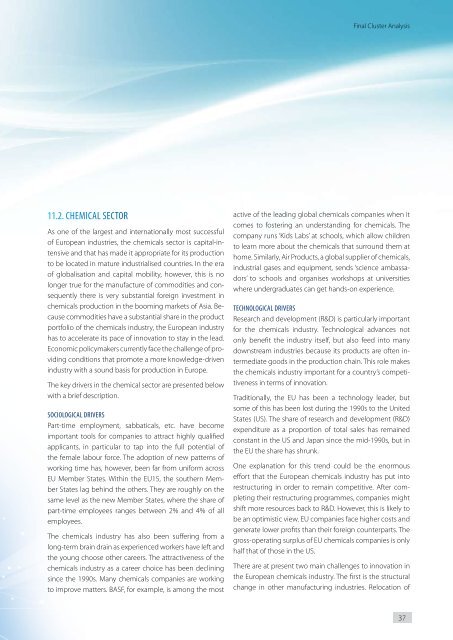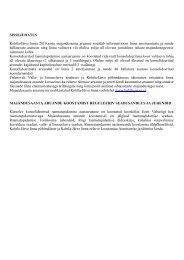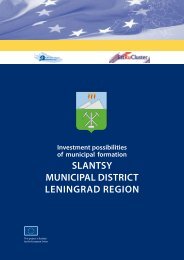FINAL CLUSTER ANALYSIS - Kohtla-Järve
FINAL CLUSTER ANALYSIS - Kohtla-Järve
FINAL CLUSTER ANALYSIS - Kohtla-Järve
You also want an ePaper? Increase the reach of your titles
YUMPU automatically turns print PDFs into web optimized ePapers that Google loves.
11.2. chemIcal sector<br />
As one of the largest and internationally most successful<br />
of European industries, the chemicals sector is capital-intensive<br />
and that has made it appropriate for its production<br />
to be located in mature industrialised countries. In the era<br />
of globalisation and capital mobility, however, this is no<br />
longer true for the manufacture of commodities and consequently<br />
there is very substantial foreign investment in<br />
chemicals production in the booming markets of Asia. Because<br />
commodities have a substantial share in the product<br />
portfolio of the chemicals industry, the European industry<br />
has to accelerate its pace of innovation to stay in the lead.<br />
Economic policymakers currently face the challenge of providing<br />
conditions that promote a more knowledge-driven<br />
industry with a sound basis for production in Europe.<br />
The key drivers in the chemical sector are presented below<br />
with a brief description.<br />
socIologIcal DrIvers<br />
Part-time employment, sabbaticals, etc. have become<br />
important tools for companies to attract highly qualifi ed<br />
applicants, in particular to tap into the full potential of<br />
the female labour force. The adoption of new patterns of<br />
working time has, however, been far from uniform across<br />
EU Member States. Within the EU15, the southern Member<br />
States lag behind the others. They are roughly on the<br />
same level as the new Member States, where the share of<br />
part-time employees ranges between 2% and 4% of all<br />
employees.<br />
The chemicals industry has also been suff ering from a<br />
long-term brain drain as experienced workers have left and<br />
the young choose other careers. The attractiveness of the<br />
chemicals industry as a career choice has been declining<br />
since the 1990s. Many chemicals companies are working<br />
to improve matters. BASF, for example, is among the most<br />
Final Cluster Analysis<br />
active of the leading global chemicals companies when it<br />
comes to fostering an understanding for chemicals. The<br />
company runs ‘Kids Labs’ at schools, which allow children<br />
to learn more about the chemicals that surround them at<br />
home. Similarly, Air Products, a global supplier of chemicals,<br />
industrial gases and equipment, sends ‘science ambassadors’<br />
to schools and organises workshops at universities<br />
where undergraduates can get hands-on experience.<br />
technologIcal DrIvers<br />
Research and development (R&D) is particularly important<br />
for the chemicals industry. Technological advances not<br />
only benefi t the industry itself, but also feed into many<br />
downstream industries because its products are often intermediate<br />
goods in the production chain. This role makes<br />
the chemicals industry important for a country’s competitiveness<br />
in terms of innovation.<br />
Traditionally, the EU has been a technology leader, but<br />
some of this has been lost during the 1990s to the United<br />
States (US). The share of research and development (R&D)<br />
expenditure as a proportion of total sales has remained<br />
constant in the US and Japan since the mid-1990s, but in<br />
the EU the share has shrunk.<br />
One explanation for this trend could be the enormous<br />
eff ort that the European chemicals industry has put into<br />
restructuring in order to remain competitive. After completing<br />
their restructuring programmes, companies might<br />
shift more resources back to R&D. However, this is likely to<br />
be an optimistic view. EU companies face higher costs and<br />
generate lower profi ts than their foreign counterparts. The<br />
gross-operating surplus of EU chemicals companies is only<br />
half that of those in the US.<br />
There are at present two main challenges to innovation in<br />
the European chemicals industry. The fi rst is the structural<br />
change in other manufacturing industries. Relocation of<br />
37

















